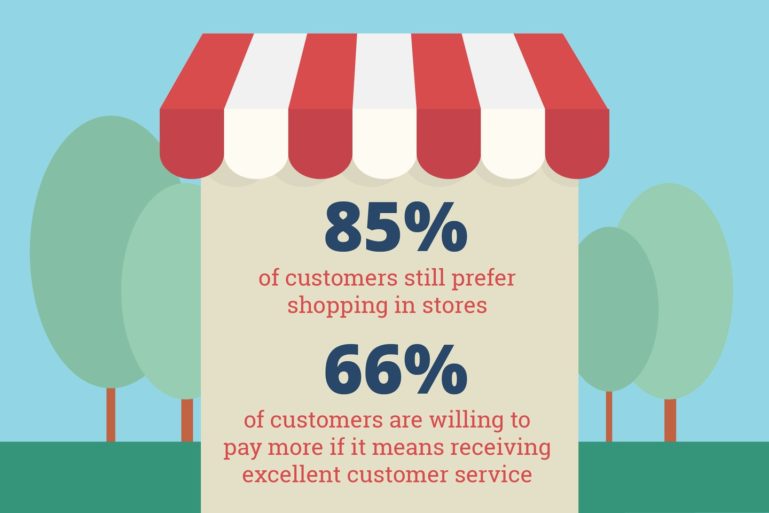
15 Retail Customer Retention Tactics for Brick-and-Mortar
With increased competition for each and every shopper’s attention, you need top-notch customer retention tactics to ensure you do more than simply sell inventory.
After all, despite the rise of online shopping, 85 percent of customers still prefer shopping in stores because they value staff input — especially when it comes to making major purchases.
A strong strategy for building retail customer loyalty means you’ll have satisfied customers, glowing word-of-mouth referrals, and open doors for years to come. To help you get started, here are 15 customer retention tactics that lead to increased sales and long-term success:
1. Provide Amazing Customer Service
If you’re not bowling your customers over with smart, friendly, and knowledgeable staff who fix problems in a flash and make every transaction painless, you might as well be sending money out the door.
According to Business Insider, 66 percent of customers are willing to pay more if it means receiving excellent customer service — and just about as many will walk out the door if service is poor.

While online transactions reduce wait times and increase customer expectations, it’s up to brick-and-mortar establishments to do what computers can’t — make service personal, meaningful, and worth coming back for. It’s an invaluable customer retention tactic.
Let’s look at an example from a customer service giant — The Apple Store. Apple does this by using friendly, helpful staff and creating opportunities for customer engagement. Just think about all those open laptop screens and the number of iPads begging to be touched. Then there’s the open-air Genius Bar, where customers sit and chat with technicians who solve their problems.
This savvy customer retention tactic turned Apple storefronts into money-making machines. They earn more than $5,500 per square foot — more than double what luxury jeweler Tiffany & Co. makes.
If it works on a large scale, it will definitely translate on a smaller scale in your business.
2. Consider the Customer Experience
When it comes to retaining techniques, your space — and how it attracts, supports, and meets customer needs — is just as important as who you hire.
Deck your walls and outfit your shelves with informative signage to position your establishment as an expert in your retail niche.This could be anything from details about the sweatshop-free ethics of the companies you purchase from to profiles of local artisans. How businesses approach this customer retention tactic will vary from store to store. Just make sure that the experience you create is unique to your brand appropriate for your customers.
Another tip is to update and rotate your stock. This will entice customers to check back and see what’s new in your store. Be sure to invest in a top-notch inventory management system, so it’s easier to stay on top of your stock levels and know when to reorder popular items. If you always have what a customer needs — and a plan for how to get the product to them when you run out — your customers will trust you to deliver the goods. Literally.
3. Eliminate Pain Points
The best customer retention strategies reduce the pain points for customers — such as circling the parking lot to nab a spot, the frustration of the words “only available online” or unwelcome challenges at checkout.
There are a number of factors that determine whether you’re able to offer free parking. But, even if you aren’t able to offer free parking, you could partner up with other local establishments to create a validation program that eases parking costs for your customers. Goodwill also goes a long way in strengthening the community among you and other local small businesses.
Online sales that aren’t integrated with your storefront can be another potential customer roadblock. There can be many reasons why people may not want a product delivered to their home. Offering on-site pick-up means they know someone will be there to receive the item and they’ll have a relationship with the business from which they made the purchase. Free in-store pick-up is also easy to execute and doesn’t cost a penny to implement — no matter how big or small your business may be.
If shipping costs are a challenge, you could add the cost of shipping to products, institute a minimum purchase price that offsets free shipping costs or offer free shipping during peak seasonal periods.
Are there challenges within the layout or operation of your business? Start by making your checkout counter the most approachable and easiest to navigate area in your store.
Customers who feel comfortable approaching the front of your store will be more likely to strike up a conversation or learn more about your products. They’ll view your store as a place to build relationships, rather than just make transactions.
If you sense that a good portion of your customers are watching every minute of their time, you could experiment with pay-and-go mobile technology.
4. Ensure Your Staff is Knowledgeable
Whether you’re shopping for a new dress or the perfect read for your next book club meeting, you want to talk to a salesperson who can give you sound advice and an expert opinion. In fact, customers are more likely to return to your store if they think of you and your staff as the experts who can solve a problem or instantly meet their needs.
When you’re hiring, look for staff members with incredible listening skills, a friendly and energetic personality, and the understanding that relationship-building is key. Good listeners are more likely to ask the right questions and funnel meaningful feedback to management to address any issues.
Coupled with ongoing training, staff members who have good social skills will ensure that customers feel comfortable, valued, and ready to return.
SEE ALSO: The Small Retailer’s Guide to Successful Staff Training
5. Engage Customers
Have a new product on your shelves? Offer demonstrations that give customers a chance to see how it will make their lives better. Get your staff in the mindset of asking questions about customer tastes and checking customer sales history in your POS system. This way, they can tailor product recommendations accordingly.
Most importantly, be open to receiving feedback. In fact, you should ask for it! It can be as simple as inviting customers to review you on Google or Yelp.
Be prepared for complaints with a detailed customer service plan, so your staff knows exactly how to turn unhappy customers into happy ones.
Make it clear that you not only value customer input but actively use it to make your services better — time and time again.

6. Adopt an Above-And-Beyond Mentality
Can you remember the last time a store went out of their way to help you get what you needed? Think about the bookstore that special-ordered that hard-to-find first edition or the specialty food shop that stayed open a few extra minutes to let you grab an additional item.
Dynamic and proactive businesses make relationship building and problem-solving their priorities. It’s these relationships that ensure repeat business. Encourage your staff to listen to and observe customers, then act based on customer feedback — whether that’s fixing a problem immediately or offering a refund to make up for a mistake.
Since plenty of brick-and-mortar stores also have online storefronts, make sure your support channels all work together to incorporate and respond to feedback.
7. Get Familiar
What’s in a name? Since customer retention is all about relationship building — it’s everything.
Train your staff to remember and engage with repeat customers. Even a simple, “Hey, Megan — want a soy latte today?” will ensure that Megan always comes to your neighborhood for her caffeine fix.
This tactic can also translate to your online communications. Highlighting staff names and faces in social media and online marketing — including your newsletter — can help close the distance between the internet and real life. If your customers recognize your staff from online communication, they’ll feel more comfortable engaging. Your expertly trained staff can take it from there.
8. Shower Customers With Love
When customers have a lot of options, it’s the little gestures that set you apart from your competitors. Things like handwritten thank you notes for new or repeat clients or small gifts and samples let your customers know how much you appreciate their business. These gestures also make great word-of-mouth stories that bring customers in.
9. Plan a Full Calendar of Events
Events are often used as a customer retention tactics and for drumming up new business — and they work. When executed correctly, an engaging event calendar will solidify your place as a top-notch store and retail establishment.
Customer retention is all about building trust and loyalty. Events show that you plan to stick around and signal just how indispensable you are to those who need your services. Plus, they’re fun.
For example, if you’re a designer furniture store, think about holding monthly conversations with local experts on how to maximize a small space. Or partner with a local bookstore to host the launch for a new coffee table book by an industry expert you admire. Classes and workshops can also re-engage customers who may need a reason to stop in and see what’s new.
10. Get Creative With Your Offers
If you want customers to stick around, make it worth their while to give you their attention — and their email address.
You’ve probably already experimented with strategic sampling so that customers look forward to seeing what you have on display. Now apply this mindset to customers who engage with you online as well. Bridge the gap between your online platforms and your retail space by offering “secret sales” for your social media followers — and entice them back in the door.
Want to get even more high-tech? Try using beacons — push notifications for mobile phone users — that send customers in your neighborhood special deals. Think digital coupons, details about time-specific sales, or free parking for their shopping trip.
Make it clear to customers who come into your store that you have their backs and that they’ll be rewarded for shopping with you.
11. Follow Up in a Timely Manner
By using automated tools to schedule follow-ups with your customers, you position yourself as friendly and helpful — and let them know you’re thinking about their convenience.
According to Client Heartbeat, these simple customer retention tactics work. When ProFlowers started using reminder emails for past clients during holidays, like Valentine’s and Mother’s Day — they saw an immediate uptick in sales. Similar tactics can be used for small business as well. This kind of anticipation isn’t just good marketing — it’s also excellent customer service.
12. Turn Existing Customers Into Advocates
According to Research Live, word-of-mouth referrals account for as much as 13 percent of a brick-and-mortar business. But how do you go from happy repeat customers to glowing recommendations and new business?
Drive word-of-mouth business by turning existing customers into brand advocates — individuals you cultivate to promote your business through word-of-mouth and online. These are your star customers, the social butterflies who will talk you up around town and provide you with social proof online.
While brand advocates are often tapped as a way to bring in new business, treating your advocates well — with incentives like discounts and gifts — shows that you value them as repeat customers.
13. Reward Loyal Customers
Take the old 80/20 adage seriously — 80 percent of profits come from 20 percent of your customers. Once you identify this 20 percent, reward them.
Rewarding customers for purchases with further discounts can drive overall sales. Even more importantly, your reward system doesn’t have to be complicated for customers to feel valued.
Whether you offer a free coffee for every ten a customer buys or a 10% discount for client referrals, make it easy for your best customers to feel the love.
The easier it is for customers to join your rewards program, start racking up points and track their progress, the more likely you are to retain their business.

14. Reconnect With Lost Customers
Research shows that you have a 20 to 40 percent chance of winning back an ex-customer versus a mere 5 to 20 percent of converting a prospect into a new customer.
If you’re a wine store, hold a tasting and invite your email list. If you’re a clothing boutique, offer a discount to shoppers who attended an event on wardrobe styling.
Your customers sometimes need a reminder about what makes you the place to shop. By gently increasing your touchpoints, especially on social media channels or through email follow-ups, you can regain older customers that might have fallen off the radar.
15. Design Seamless Online & In-Store Experiences
Brick-and-mortar retail spaces and online stores are no longer separate spaces. They work together to provide a single — and singular — customer experience.
Offering free online shipping for items not in stock at your location or in-store pickup for online ordering are great customer retention tactics that blend the best of both worlds. These strategies get customers back in the door while providing streamlined service and convenience.
Integrating mobile shopping into your brick-and-mortar establishment can help bridge the gap between online and in-person sales.
For example, retail stores can roll out loyalty barcodes for mobile users. Customers then receive discounts at the register just for showing their phone screens. By meeting these customers where they’re at, in the moment — on their phone or on the web — you’ll make it more likely for them to continue making a purchase in-store or online.
As ecommerce sales trend upward, it’s important to develop a 360-degree view of your business. The better your online and brick-and-mortar services work together, the easier it will be to serve and retain customers.
Whether they walk in off the street or find you through a mobile or online search, your customers deserve the best. Effective customer retention tactics are surefire ways to develop relationships with customers who will always come back.
Want to try ShopKeep for yourself?
Just answer a few easy questions.
Need help finding the right point of sale?
Just complete the form. We’ll call you right back to explain how ShopKeep can work for you.
Hit the ground running.Sprinting, in fact!
Read our free, comprehensive guide, Small Business 101, to learn all you need to know about starting a thriving business.

